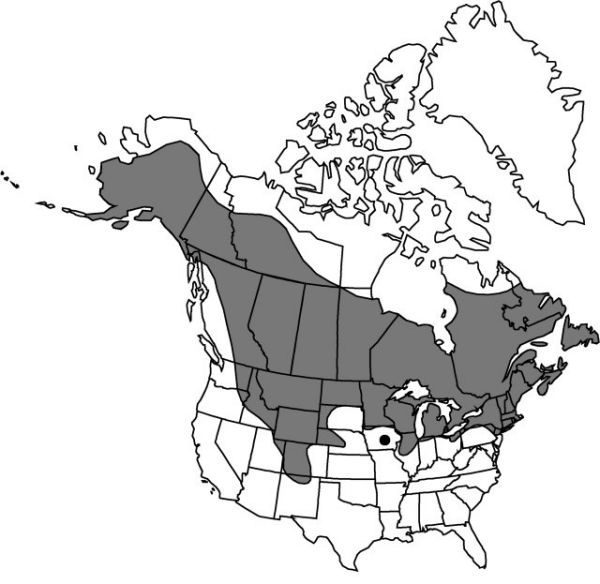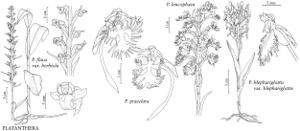Platanthera aquilonis
Lindleyana 14: 193, figs. 1–5. 1999.
Plants 5–60 cm. Leaves few–several, ascending to arcuate-spreading, scattered along stem, gradually reduced to bracts distally; blade oblong to linear-lanceolate, 2.7–23 × 0.4–4 cm. Spikes lax to very dense. Flowers resupinate, not showy, yellowish green with dull yellowish lip, or more whitish green under cool conditions; lateral sepals spreading to reflexed; petals rhombic-ovate- to lance-falcate, margins entire; lip descending, projecting, or apex adhering to dorsal sepal and petal apices, rhombic-lanceolate to lanceolate, without basal thickening, 2.5–6 × 1–1.5 mm, base not rounded-dilated, margins entire; spur clavate or sometimes rather cylindric, 2–5 mm, apex usually broadly obtuse; rostellum lobes divergent, directed downward, very small, rounded, obscure; pollinaria straight; pollinia rotating forward and/or fragmenting, loose pollen masses free of anther sacs and trailing downward onto stigma; viscidia orbiculate; ovary rather slender to stout, mostly 5–13 mm. 2n = 42.
Phenology: Flowering May–Aug.
Habitat: Wet meadows, tundra, marshes, fens, stream banks, shores, ditches, seeping slopes, roadsides, borrow pits, mesic deciduous forest slopes
Elevation: 0–2500 m
Distribution

Alta., B.C., Man., N.B., Nfld. and Labr., N.W.T., N.S., Ont., P.E.I., Que., Sask., Yukon, Alaska, Colo., Conn., Idaho, Ill., Ind., Iowa, Maine, Mass., Mich., Minn., Mont., Nebr., N.H., N.J., N.Mex., N.Y., N.Dak., Ohio, Oreg., Pa., R.I., S.Dak., Utah, Vt., Wash., Wis., Wyo.
Discussion
Flowers of Platanthera aquilonis are usually scentless, but in the far northwest they have a sweet, pungent scent, like that of some related species. The flowers are commonly self-pollinating: the pollinia rotate forward and downward, contacting the stigma, and/or the pollen masses dissociate and are deposited on the stigma as if they had sifted downward.
Platanthera aquilonis is a North American diploid species long confused with the tetraploid Icelandic P. hyperborea (Linnaeus) Lindley. Flowers of both species autopollinate, although the details of the mechanisms may differ. The two species differ in column structure and lip and viscidium shape. True P. hyperborea is similar to P. huronensis, and the relationship of these two species needs further study.
Selected References
None.
